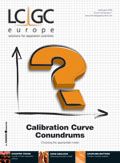Country Focus: Pole Positions
Doug Kitson looks at some of Poland's leading separation science groups.
Research group: Professor Edward Bald, Dr Grażyna Chwatko, Dr Paweł Kubalczyk, Dr Rafalł Głowacki, PhD Student Kamila Borowczyk and six MSc students, Department of Environmental Chemistry, Faculty of Chemistry, University of Łódź, Łódź.

Research focus: The aim of this team is to solve environmental problems — specifically in environmental health — by developing new analytical methods to determine exogenous and endogenous sulphur-containing compounds in biological fluids.
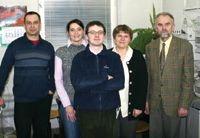
The main areas of research are new thiol-specific derivatization reagents for biological sample analysis by liquid-phase separation techniques and new analytical methods to determine homocysteine and metabolically-related thiols in biological samples. The team also studies the mechanism of atherogenic action of homocysteine on blood vessels in humans and the homocysteinylation of proteins by homocysteine thiolactone. The role of hydrogen sulphide in mammals, the redox status of thiols in physiological liquids in humans and food, and the application of high performance liquid chromatography (HPLC) and capillary electrophoresis (CE) for monitoring endo- and exogenous thiols in physiological liquids in humans, are also researched, as well as on-capillary pre-concentration in CE and clinical chemical analysis and toxicological analysis. The group is equipped with several fully computerized HPLC and CE instruments connected to ultraviolet/visible (UV/vis), fluorimetric, electrochemical and refractometric detectors, as well as fully automated biological sample preparation systems encompassing dialysis, trace enrichment and solid-phase extraction (SPE).
The staff of the group teach environmental analytical chemistry, including separation techniques, to undergraduate and graduate students. Six Master's theses are submitted annually from this research group.
E-mail: ebald@uni.lodz.pl
Research Group: Professor Boguslaw Buszewski (Head of the Chair), Dr Andrzej Chmarzynski, Dr Renata Gadzala-Kopciuch, Dr Ewa Klodzinska, Dr Przemyslaw Kosobucki, Dr Tomasz Kowalkowski, Dr Magdalena Ligor, Dr Tomasz Ligor, Dr Myroslav Sprynskyy, Dr Sylwia Studzin'ska, Dr Michal Szumski, Dr Monika Michel and 8 PhD students; technical staff — Piotr Przyzycki and administrative staff — Agnieszka Reczuch and Joanna Kowalska, Faculty of Chemistry, Nicolaus Copernicus University and the Centre for Education and Research in Separation Methods and Bioanalytics (BioSep), Torun.
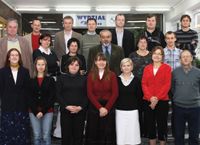
Research focus: The activities of the group are focused on theoretical and practical research in the fields of physico-chemical separation, pollution analytics, chemical and biological monitoring, waste utilization, xenobiotics bioaccumulation, metabolomics, speciation, sample preparation and chemometrics.
Thanks to full-scale research in the field of separation and related proficiencies (chromatography, electromigration, spectroscopy and hyphenated techniques) and analytical techniques, cooperation with scientific centres both within the country and abroad is continuously expanding. It allows a simple way to recognize common programmes on a regional, national or European Union basis (such as academic teachers and students exchanges within the TEMPUS, CEEPUS, SOCRATES-ERASMUS, V and VI Framework Programmes).
Research is focused not only on pure chemistry issues, but also on environmental, physical and analytical chemistry within the Chair. Therefore, the group is involved in experiments and studies that include biology and microbiology (cell, biological membrane, bacteria), medicine (medical diagnostics, cancerous diseases), pharmacy (metabolomics and drug quality control) and nanotechnology (porous polymers, new materials for separation techniques, micro- and nanocolumns). Lately the group has undertaken research concerning fast diagnostic tests for cancer detection. The involvement in this course allows them to prepare new methods for the realization of interdisciplinary researches. This is the result of material studies and devices that are necessary for collecting samples and coupling them with GC–MS, LC–MS, CZE–MS and hybrid systems. This includes successfully implemented new generations of stationary phases and columns.
The next important aspect of their scientific activities is miniaturization. It offers methods and devices using miniature structures (chip-based methods) to sample separation, clinical applications and biochemistry. This research is realized by both the coupling of techniques of on-line systems and by procedures and method automations to eliminate errors during standard analysis.
Biodegradation processes and neutralization of waste is among the other subjects of interest. The main aim is related to the negative influence of heavy metals and hence an understanding of their behaviour in the soil (speciation).
Professor Boguslaw Buszewski is the chairman of the Separation Sciences Committee of Polish Academy of Sciences, Polish representative of separation science in Europe and has also been elected to the Steering Board of the European Society for Separation Sciences (EuSSS).
E-mail: agar@chem.uni.torun.pl
Research Group: Professor Teresa Kowalska, Dr Mieczysław Sajewicz, PhD students (Monika Gontarska, Dorota Kronenbach, Dorota Staszek and Łukasz Wojtal), and an MSc student (Ms Magda Wróbel), Department of General Chemistry and Chromatography, Institute of Chemistry, University of Silesia, Katowice.
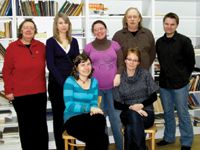
Research focus: The main interests of the research group involve developing non-trivial applications of chromatographic techniques to solve challenging physico-chemical and analytical tasks. These techniques include thin layer chromatography (TLC), gas chromatography (GC), high performance liquid chromatography (HPLC), flash chromatography (FC) and certain hyphenated chromatographic techniques, including GC–MS and LC–MS.
As a result of the group's interests, spontaneous oscillatory reactions of chiral conversion have been discovered with a fairly wide variety of low-molecular-weight chiral carboxylic acids, many of them of vital importance to humans (for example as profen drugs, amino acids and hydroxy acids). This research has a number of exciting aspects; the organic oscillatory reactions discovered so far (which obey the rules of non-linear dynamics) are much less common than the purely inorganic, or mixed oscillatory reactions. So far, chiral conversion of profen drugs, amino acids and hydroxy acids has only been reported for the compounds dissolved in the biotic media, whereas the group claims to have found this for the abiotic systems as well. They have also managed to show the performance of TLC in physico-chemical research dedicated to chirality and also for tracing the dynamics of the oscillatory chiral conversion.
Within the group's analytical interests, a wide range of chromatographic techniques are used to analyse plant material. Headspace gas chromatography with a mass spectrometry detector (HS-GC–MS) is used to separate and identify the volatile organic compounds (VOCs), whereas flash chromatography (FC), HPLC-DAD (diode array detection) and liquid chromatography mass spectrometry (LC–MS) are used to assess other constituents of the plant material. In this laboratory, there are two main goals to this kind of research. Firstly, there is a need for a new approach to plant systematics and it appears that chemosystematics can be a good alternative to biological systematics, with advanced chromatographic techniques as its most efficient working tools. Secondly, the kingdom of plants can serve as an ingenious blueprint for drug design, challenging other, less nature-inspired approaches to the same task.
E-mail: kowalska@us.edu.pl
Research group: Professor Roman Kaliszan, Department of Biopharmaceutics and Pharmacodynamics, Medical University of Gdańsk, Al. Gen. Hallera 107, 80-416, Gdańsk.
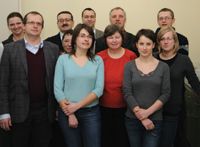
Research focus: The team led by Prof. Roman Kaliszan combines chromatography with chemometrics in their research. The first two papers, which are thought of as initiating an original research field within the chemometrics field, namely QSRR (Quantitative Structure-Retention Relationships), appeared at the same time in 1977: one by R. Kaliszan in Chromatographia and second by I. Michotte and D.L. Massart of Vrije Universiteit Brussel in Journal of Pharmaceutical Sciences. Soon after that, QSRR became a rapidly developing research topic with numerous important publications from various laboratories in Poland and abroad.
In original reports by the Gdańsk group, the QSRR were demonstrated to provide information on the chromatographed analytes that could be useful for medicinal chemistry and molecular pharmacology, along with information on fundamental chemical behaviour and practical ways to optimize the conditions of chromatographic separations.
There are a number of important implications of the QSRR — derived in the Department of Biopharmaceutics and Pharmacodynamics for separation science — such as improved methods and procedures to determine drug and drug candidate lipophilicity (hydrophobicity) by HPLC; the first HPLC method to assess the hydrophobicity of non-dissociated basic (as well as acidic and neutral) analytes by the application of a high pH-resistant polybutadiene-coated alumina stationary phase; and also the first applications of the so-called immobilized artificial membrane (IAM) stationary phase to get biorelevant measures of lipophilicity.
An original theory and procedure of the pH-gradient HPLC was developed here, in a series of 10 papers, published mostly in Analytical Chemistry. A comprehensive, thermodynamically consistent theory of pH-gradient and combined pH/organic modifier-gradient liquid chromatography has been developed, which allowed a fast and simultaneous determination of analyte pKa and lipophilicity. The procedure is applicable to analyte mixtures and requires only minute amounts of substances. It offers new, unique possibilities of efficient separation of ionizable compounds. It may also be a method of choice for high-throughput pre-selection of drug candidates of expected suitable pharmacokinetics from a multitude of compounds provided by current methods of combinational chemistry and automated synthesis.
From QSRR there came the application of HPLC stationary phases with immobilized biomacromolecules to model interactions with drugs and using the obtained chromatographic data in correlation studies of the structure of drugs. They also elaborated on a new original analytical method for proteomics consisting of applying QSRR to predict the retention of peptides using three simple structural descriptors.
E-mail: roman.kaliszan@amg.gda.pl
Research group: Professor Irena Baranowska, Department of Analytical and General Chemistry, Silesian University of Technology, M. Strzody Str. 7, Gliwice.
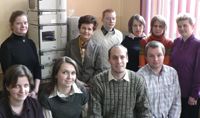
Research focus: This analytical department is active across the broad spectrum of analytical chemistry, especially preliminary and applications research in bioanalytical chemistry. Their research concerns developing new extraction and determination methods for endogenic compounds (biogenic amines, methylxantines, aminoacids) as well as egzogenic compounds (drugs of different therapeutical groups and heavy metals) in physiological solutions.
New high performance liquid chromatography (HPLC) methods for dopamine, serotonine and their metabolites, as well as caffeine, teophiline, teobromine and their metabolites in urine samples have been developed, in addition to HPLC and voltamperometric procedures to determine dozens of different drugs and their metabolites in physiological solutions and pharmaceuticals. These procedures and methods may be applied to monitor drug therapy, especially in cases that involve the simultaneous application of different drugs (polyteraphy).
The group's interests also focus on the extraction methods of flavonoides, as well as methods to determine them in stimulants and physiological fluids using HPLC. The team also conduct research concerning the extraction and determination of pesticides in trophic chain samples. Special emphasis is placed on extraction procedures: liquid–liquid (microwaves and ultrasound assisted) and solid-phase extraction (columns and speedisks).
The photo features people who work with chromatography. However, other forms of research are also conducted in the department, including comestible immunoenzymatic methods for atrazine (herbicide) determination, and preliminary research concerning electrochemical reactions of different drugs, disinfectant agents and biogenic amines depending on the type of electrode used. The presence of heavy metals by flame atomic absorption spectrometry (FAAS) and graphite furnace atomic absorption spectroscopy (GFAAS), and voltamperometric methods in environmental, comestible and biological samples are also investigated.
E-mail: irena.baranowska@polsl.pl
Research team: Professors: Jacek Namieśnik (head of department), Marek Biziuk, Marian Kamiński, Józef Pacyna, Waldemar Wardencki, Bogdan Zygmunt; associate professors: Piotr Konieczka, Żaneta Polkowska, Lidia Wolska; assistant professors: Agata Kot-Wasik, Andrzej Wasik, Bożena Zabiegała; 29 postgraduate (PhD) students. Department of Analytical Chemistry, Gdansk University, Gdansk.

Research focus: The department of analytical chemistry has a broad programme of research in analytical chemistry, with special emphasis on the application of different chromatographic techniques to investigate the state of the environment and the processes taking place in it.
Current projects include the development of new methods to determine trace components in samples of complex matrices, the design, construction and testing of the analytical characteristics of prototypical monitoring/measurement devices and an assessment of the environmental fate of xenobiotics and of bioaccumulation processes in tissues and organs of living organisms. In addition the group works on the application of state-of-the-art analytical techniques for the quality control of petroleum, industrial and food products, the development of new techniques for producing materials with special properties and/or chromatographically tested high-purity-grade materials, as well as being involved in the organization of inter-laboratory studies and proficiency testing.
They also work on the construction and testing of standard gas mixture generators and construction of special modules for coupling to commercial monitoring/measurement instruments such as gas/liquid chromatographs, environmental pollutant monitoring devices designed for isolation and/or pre-concentration of analytes, deoxygenation, desiccation and purification of gas streams and the liberation of analytes from traps (thermal desorbers, cryogenic traps).
In addition to these projects, the staff of the Department of Analytical Chemistry is involved in training courses in the operation of analytical instruments (in-service training for faculty personnel), gas and liquid chromatography (for different levels of experience) and sample preparation for analysis. There is also postgraduate study courses in the analytics of food and environmental pollution and quality control (QC) and quality assurance (QA) of analytical measurements, as well as European projects for Master studies including a European Joint Master in Quality in Analytical Laboratories (emQal, http://cursos.ualg.pt/emqal/), and the Euromaster "Analytical Science at the Interface" (http://www.pg.gda.pl/chem/pl/images/stories/Wspolpraca_Miedzynarodowa/Teaching_Project2008-20094.pdf).
The department received significant EU funds and the Centre of Excellence in Environmental Analytics and Monitoring (CEEAM) was established in 2003 (http://www.pg.gda.pl/chem/CEEAM/) with Professor Jacek Namieśnik as its director and Professor Hartmut Frank as head of its international scientific advisory board. The department was also involved in the organization of the 35th International Symposium on Environmental Analytical Chemistry (http://www.pg.gda.pl/chem/iaeac/) and the 15th International Conference on Heavy Metals in the Environment (to take place in Gdańsk) (http://www.pg.gda.pl/chem/ichmet/)
Professor Jacek Namieśnik is an editorial board member of the following analytical journals: Journal of Chromatography A, Critical Reviews in Analytical Chemistry, Acta Chromatographica, Chemical Analysis (Warsaw), Toxicological and Environmental Chemistry. He is also Chairman of the Analytical Chemistry Committee of the Polish Academy of Sciences (http://www.chem.uw.edu.pl/KChA/index.htm).
E-mail: chemanal@pg.gda.pl
Research Group: Tadeusz Dzido (head of Department), Katarzyna Czapińska, Wojciech Markowski, Beata Polak, Tomasz Tuzimski have been involved in liquid chromatography for the longest duration in the Department of Physical Chemistry, Chair of Chemistry, Pharmaceutical Faculty, Medical University of Lublin, Lublin. Other group members (Paweł Płocharz, Krzysztof Ścibiorski, Piotr Ślazak and Andrzej Torbicz) have been working in the Department for several years. Some of them are preparing their PhD theses. Three PhD students and five undergraduate students have also been performing chromatographic research in the department.

Research focus: Research performed by the group has been developed based on the chromatography school created by Professor Edward Soczewiński (middle of the front row, retired for 10 years) who was the head of the Chair of Chemistry for 34 years (1964–1998). The Department of Physical Chemistry, is part of the Chair of Chemistry. Prof Soczewiński, author of the well-known equation describing retention mechanism in normal-phase systems of liquid chromatography (Snyder–Soczewiński model of adsorption), has became the inspiration for the investigation of liquid chromatography including both normal-phase and reversed-phase systems. These investigations have involved both column and planar chromatography.
The group's research interest has focused on the retention and separation selectivity changes in relation to properties of components of the chromatographic systems, including the correlation of retention parameters and physicochemical properties of solutes, mobile and stationary phases. Correlation of retention and biological activity of compounds is also of interest.
The group has been involved in the optimization of separation conditions in liquid chromatography systems (HPLC and TLC/HPTLC, thin layer chromatography/high-performance thin layer chromatography) of various classes of solutes, especially biologically active ones, including amino acid enantiomers, pesticides, nucleosides and phenolic acids, using chemometric methods and computer simulations of the chromatographic process with programmes developed in both the department (Dr Markowski) and commercially available systems, such as DryLab and ChromSword.
Methodological aspects of the investigations in the range of liquid chromatography are also marked; especially concerning planar chromatography. The group has developed procedures for gradient development (continuous and stepwise), preparative separations, multidimensional development of chromatograms and multiple development. They have been performing investigations dealing with hyphenated techniques comprised of HPLC and TLC/HPTLC systems.
Various horizontal developing DS chambers have been designed in the department. These chambers have been used worldwide. Various methodical possibilities of planar chromatography processes have been studied for horizontal DS chambers.
From the experience gained constructing the chambers, a device for pressurized planar electrochromatography (PPEC) has been designed and the investigation of various parameters that influence the separation efficiency of compounds, especially with biological activity, have been performed with this method.
Tadeusz Dzido is an editor on the Journal of Planar Chromatography and member of the advisory board of Acta Chromatographica.
E-mail: tadeusz.dzido@umlub.pl
Research group: Professor Marek Trojanowicz (head), Professor Krystyna Pyrzynska, Dr Ewa Pobozy and Dr Magdalena Biesaga with four PhD students and eight MSc students. Laboratory for Flow Analysis and Chromatography, Department of Chemistry, University of Warsaw, Warsaw.
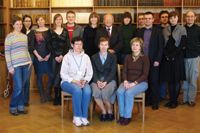
Research focus: The overall aim of the research group is to develop novel analytical methods in environmental and clinical chemistry. Current research activity is focused in the fields of high-performance separation methods [HPLC with UV/vis, fluorescence and mass spectrometry detection, capillary electrophoresis with UV/vis and laser-induced fluorescence (LIF) detection, GC], flow injection analysis (FIA), the development of chemical sensors and biosensors, trace analysis and speciation of elements with atomic spectroscopy (AS) methods.
The environmental HPLC application studies are focused on the determination of perfluorinated surfactants, residue pesticides, biogenic toxins and the chemical speciation of heavy metals in natural waters. Recently, the most important project includes the development of the methodology for the pre-concentration, separation and determination of fluoro-organic compounds in water and biological samples. Different separation methods — HPLC with fluorescence and UV (after defluorination and derivation) detection, GC with a flame ionization detector (FID) and electrophoresis — are being investigated.
Chromatographic methods are also used to determine phenolic compounds in food samples, as well as in water and wastes purified by ionizing radiation. A recent project concerned the determination and identification of natural dyes in archaeological objects. HPLC with UV, fluorescence and MS detection and CE–MS were used.
Capillary electrophoresis (CE) studies are also used to develop methods for the determination of biomolecules in biological samples. Application of CE with UV and LIF for the detection of amino acids, biomarkers and neurotransmitters and their metabolites in physiological fluids has been presented, as has the applicability of capillary zone electrophoresis (CZE) methods for the simultaneous determination of two frequently occurring microcystins. Recent projects have also concerned enzymatic in-capillary derivitization in CE.
FIA research is directed towards the determination of total organic fluoride and the speciation of trace elements with AS. In the field of sensors, studies are performed on the design of potentiometric and amperometric flow-through detectors for the purpose of enzymatic determinations of common substrates in physiological fluids in the measuring systems using microreactors with immobilized enzymes or integrated biosensors. Potentiometric chiral biosensors for amino acids determination and amperometric biosensors for aryl alcohols, pesticides and microcystins detection have also been developed.
Application of SPE methods for the pre-concentration of analytes in trace organic and inorganic analysis is studied. The electropolymerized and chemically polymerized conducting polymers and carbon nanomaterials as new materials for sample processing for pre-concentration of trace analytes from environmental samples are also investigated.
E-mail: trojan@chem.uw.edu.pl
Reversed-Phases for LC Deliberately Doped with Positive Charge: Tips and Tricks for Effective Use
May 13th 2025In this month's edition of LC Troubleshooting, Dwight Stoll and his fellow researchers discuss both the benefits (improved peak shape/loading) and challenges (excessive interaction) associated with charge-doped reversed-phase (RP) columns for both analytical and preparative separations.
Investigating 3D-Printable Stationary Phases in Liquid Chromatography
May 7th 20253D printing technology has potential in chromatography, but a major challenge is developing materials with both high porosity and robust mechanical properties. Recently, scientists compared the separation performances of eight different 3D printable stationary phases.
Detecting Hyper-Fast Chromatographic Peaks Using Ion Mobility Spectrometry
May 6th 2025Ion mobility spectrometers can detect trace compounds quickly, though they can face various issues with detecting certain peaks. University of Hannover scientists created a new system for resolving hyper-fast gas chromatography (GC) peaks.

.png&w=3840&q=75)

.png&w=3840&q=75)



.png&w=3840&q=75)



.png&w=3840&q=75)
